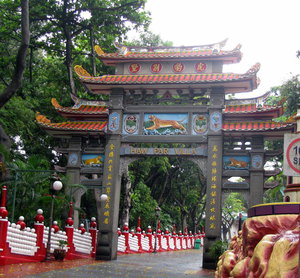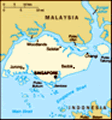Advertisement
Published: December 29th 2014

 Gate
Gate
at the entrance to Har Paw VillaI set off this morning to find the building that once housed the Tiger Balm factory in Singapore. But a little background first…
It starts in Rangoon, Burma (now Yangon, Myanmar.) A Chinese gentleman, Aw Chu Kin, was well versed in Traditional Chinese Medicine. He was encouraged to move to Burma by his uncle due to hard economic times in China. He soon set up his own physician practice and apothecary shop under the name Eng Aun Tong, or the Hall of Everlasting Peace.
He married his wife, who, in due time, produced three sons. The first died young, the second, while popular and street smart was dreadful at his studies. Some sources state that he was probably illiterate, but boy, could he talk! This son was named Aw Boon Haw, which means “gentle tiger.” The third son was quiet but a very good scholar. His name was Aw Boon Par, which means “gentle leopard,” and this was the son that took over the family business.
The younger brother (Boon Par) took his father’s recipe for his best selling ointment and improved on it. In the meantime, the older brother (Boon Haw) went into full

 tiger gate
tiger gate
note the prominent tiger head in the centersalesman mode, visiting every Chinese shop in Yangon, and talking them into stocking what was then called “Ten Thousand Golden Oils.” To guard against counterfeit medicines, Boon Haw trademarked the salve, using, of course, his own name. The ointment is now called “Tiger Balm.”
Having conquered Yangon, Boon Haw next set his sights on Malaya and Singapore. Business was booming in Malaya and Singapore – especially Singapore – and Boon Haw moved to Singapore. In 1924 he built a new factory at 89 Neil Road in Singapore, which increased production tenfold. However, he missed his younger brother, who after all, was the businessman and chemist of the business, and asked Boon Par to move to Singapore as well.
To sweeten the pot, Boon Haw built a magnificent mansion on a large and beautiful plot of land with a view of the sea. In the gardens surrounding the mansion he also placed elaborate sculptures and dioramas depicting scenes from Chinese mythology, history, and, of course, advertisements for Tiger Balm. The gardens were open to the public.
Most of these scenes had a very definite moral lesson as well. In the depiction of “Sin City” where

 Tiger Balm wrestler
Tiger Balm wrestler
Note the containers of Tiger Balm in the front.men drink and gamble, and women dance and show too much leg, you also see the downward spiral of children going hungry and men going to jail. There are a lot of scenes – purely instructive, of course –that show women trying to seduce virtuous men. I found this to be particularly amusing considering that Boon Haw was considered to be quite the womanizer, despite his four wives. There is also a very graphic depiction of the Ten Courts of Hell that continue to terrify children today.
In addition to the moral lessons implicit in the sculptures, Boon Haw also included statues to commemorate every country he visited. So, you get the Thai dancer and the American Statue of Liberty and the great apes of Burma. Originally they were all placed together in what was known as the International Corner.
But Boon Haw didn't stop with static displays for advertising. Every one of his car was outfitted with a tiger’s head – complete with red lights for eyes, a tiger striped body, and a horn that sounded like a tiger’s roar.
Things were looking very good for the brothers until World War II happened. The

 1925 Buick
1925 Buick
This is a 1925 Buick that was used to promote Tiger Balm. This was the first year that Buick produced cars with four wheel brakes.Japanese attacked Singapore just hours after the attack on Pearl Harbor. The Japanese cruelty to captured Chinese – especially rich and cultured Chinese – was legendary, and Boon Haw fled to Hong Kong. Boon Par decided to go back to his hometown in Burma, figuring he would rather die in the country of his birth than in Singapore.
The Japanese commandeered Haw Par Villa due to its commanding view of the sea, and hey, it was a very nice house. By the time the war was over and the Japanese had surrendered, the mansion was in ruins and was subsequently torn down. When Boon Haw returned after the war, he removed the damaged villa. Boon Par died in Burma. Boon Par’s son took over the business, but lost control of it in 1971.
So, back to today; I was walking down Neil Road looking for 89 Neil Road, the site of the first Tiger Balm factory in Singapore. I was walking in the five-foot way when I saw a sign hanging from the ceiling that said “Aw Boon Haw.”
“Hmm,” says I. “Aw Boon Haw is dead, and the company was bought

 89 Neil Road
89 Neil Road
The first Tiger Balm factory in Singaporeout in 1971, so who is using this man’s name?” Turns out that while Tiger Balm is no longer owned by the descendants of Boon Haw and Boon Par, Boon Haw’s son-in-law developed an analgesic patch for arthritis called Act-Q patch, which they market on-line. The building is still there, a conserved three story, though it is no longer used for manufacturing. The young lady in the office seemed pleased, and maybe a little surprised, to hear that Tiger balm was widely available in the US.
And Tiger Balm Gardens is still there, and open to the public for free. Some of the statues are in poor repair, but the Singapore Tourism Board is in the process of sprucing them up.
Advertisement
Tot: 0.075s; Tpl: 0.018s; cc: 12; qc: 24; dbt: 0.0188s; 1; m:domysql w:travelblog (10.17.0.13); sld: 1;
; mem: 1.1mb
























D MJ Binkley
Dave and Merry Jo Binkley
Tiger Balm
A great story. Glad you are enjoying the world.